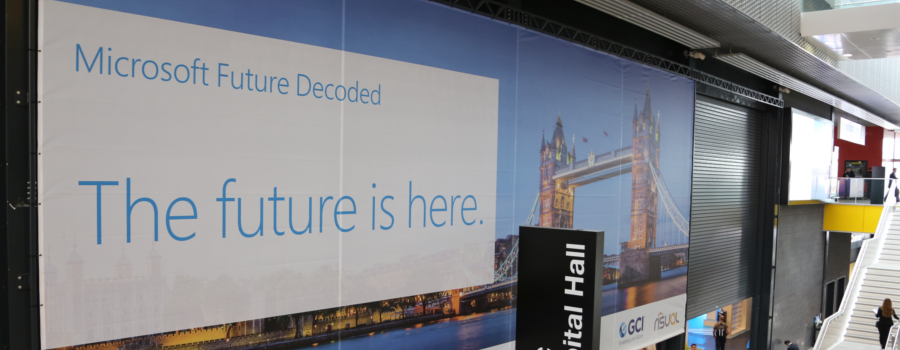Future Decoded Day 1 - The Technical Keynote

Miss the technical keynote from Future Decoded 2017? Not to worry, as we have a roundup of the speakers and topics that were discussed.
The keynote was kicked off by Uli Homann, Distinguished Architect for Cloud and Enterprise at Microsoft. He presented on the 'New Rules' of IT; abstractions and ideas about the direction in which IT is moving.
One such rule was watching out for the AI tidal wave, something that those in IT should know is coming. His advice was to 'ride' it, by embracing AI and having fun with what it can do for your business. There's plenty of exciting things that can be done with AI right now, and we don't yet know where the top of the wave is.
Watch out it’s coming ! #FutureDecoded pic.twitter.com/T9UBXgCI4H
— Martin Boam (@martinboam) October 31, 2017
He also spoke about confidential computing, something that Microsoft and Intel are working on together to ensure customers can process their data in the cloud with the assurance that it is always under customer control. If you're interested in learning more about confidential computing, you can sign up for the early access program.
To round off the start of opening of the keynote, Uli talked about how open source is the new normal. Azure is an open cloud, where its users are invited to use the languages and tools that they're familiar with, rather than the ones that we prefer. To accommodate this, Microsoft has partnered deeply across the ecosystem, to ensure the software you want is where you want to be. Microsoft is also contributing to open source across the board, such as making .NET open source so that that users can help us improve the .NET standard for the benefit of all users. We're the largest contributor to open source on Github, and we also joined the Linux Foundation.
Microsoft’s continued commitment to open source makes me a happy little geek #FutureDecoded pic.twitter.com/Wm8rbCRzCx
— Mike Rogers (@DuckMangler) October 31, 2017
Next on stage was Dell, with Senior Vice President Dayne Turbitt talking about their digital transformation, how they enable the digital transformation of their customers, and that Dell's purpose is to create technologies that drive human progress. Dayne mentioned that there are four different areas of transformation they are focusing on: digital transformation, IT transformation, workforce transformation and security transformation.
Digital and IT transformation are the most important business transformations for future success... #FutureDecoded pic.twitter.com/HrSUwVTULr
— Objective Computing (@ObjectiveIT) October 31, 2017
This was followed by a brief interview-style segment, featuring Claire Vyvyan, Senior Vice President at Dell, discussing digital transformation with Stuart Nielsen-Marsh, Director of Microsoft Strategy at Pulsant. They spoke in depth about the ways in which Dell, Microsoft and Pulsant are coming together to enable digital transformation, and you can find out more in this comprehensive write-up.
Joseph Sirosh, Corporate Vice President of Artificial Intelligence & Research at Microsoft was next on stage, to talk about how we are at the beginning of the AI Acceleration, where in a similar fashion to Moore's law, AI will see significant leaps and bounds for the foreseeable future.
While people developing AI might be shooting for software that can interpret and understand data without any human input, we are currently, for the most part, building systems of intelligence. One such system can be seen at Unilever, who have a bot that can handle basic HR enquiries from employees. It frees up some time for the HR staff to focus on the more complex enquiries.
Comment l'#IA peut pallier les troubles du langage
Pour sa solution Helpicto, @EQUADEX utilise les technologies Microsoft ⤵️#experiences17 pic.twitter.com/I8aW20fumg— Microsoft France (@microsoftfrance) October 4, 2017
The above video was also played during the presentation, which shows how Equadex is using Microsoft technologies and AI to improve the communication between carers and people with severe autism.
Up last was Chris Bishop, Laboratory Director at Microsoft Research Cambridge, to talk about building better AI through research.
We're at the dawn of the AI revolution, but why now? It's the coming together of three ingredients:
- Massive computing power - We have this thanks to the cloud, which is the epicentre of the revolution.
- Powerful algorithms - Which has seen a major upgrade with deep learning.
- Big data - The availability of data on a massive scale.
There are loads of machine learning algorithms, but they're not all suited for the same scenarios. There is no such thing as a universal machine learning algorithm. The goal of machine learning is to find an algorithm that is well matched to the problem at hand.
Big data is the fuel that powers machine learning, and it's machine learning that is creating this AI revolution.
New data security and #ML Experiments within secure enclaves #Security #Privacy @ChrisBishopMSFT #FutureDecoded #AzureStack pic.twitter.com/zsPzL683eS
— Lee Stott (@lee_stott) October 31, 2017
Chris also touched on some of the work that Microsoft Research is doing on machine learning, such as enabling data from multiple sources to be used without it being seen by everyone involved. As an example, patient data from multiple hospitals could be used to improve prediction and identification of health problems in a situation that means the medical data isn't accessible by the other parties, or by the host.